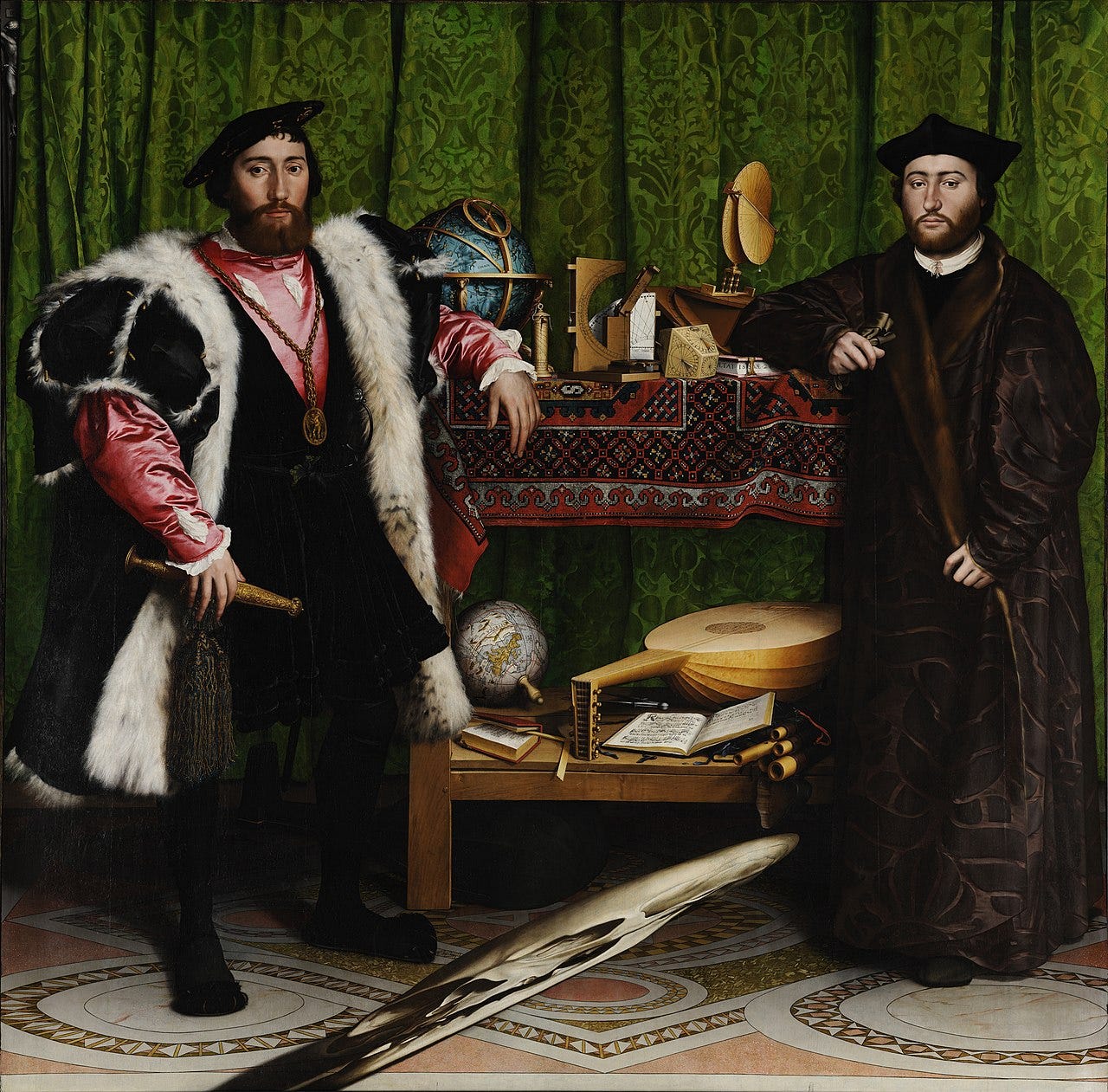The Ambassadors: A Memento Mori
Perspective, beauty, faith and death
One of my favorite paintings of the 16th century is perhaps one of the strangest.
Hans Holbein the Younger's painting "The Ambassadors" from 1533 is a masterpiece of striking complexity with rich meticulous detail and symbolism, that encapsulates the turbulent historical and cultural milieu during the Reformation. The painting features two prominent French diplomats, Jean de Dinteville and Georges de Selve. At first glance, "The Ambassadors" appears as a standard double portrait, but upon closer examination, it becomes a rich tapestry of Renaissance humanism, religious tension, and a reminder of mortality—a memento mori.
Historical Context
16th century Europe was a time of burgeoning humanist thought and seething with religious upheaval. Martin Luther's Ninety-Five Theses (1517) ignited the Protestant Reformation, challenging the Roman Catholic Church's hegemony and leading to seismic schisms across Christendom and political alliances.
Holbein’s patrons, Jean de Dinteville and Georges de Selve, epitomize the Renaissance polymath, and their inclusion in the painting visually articulates the multidimensional pursuits of Renaissance scholars. The two figures appear almost as bookends to the composition. Dressed in opulent fabrics with expressions both confident and contemplative, Jean de Dinteville and Georges de Selve stand in contrast to each other. De Dinteville, on the left, projects an imposing, worldly presence complete with a ceremonial dagger and fur-lined cloak. De Selve, more somberly attired in clergy garb, reflects a quieter, perhaps introspective strength. Their poses – one slightly leaning against the table, the other standing erect – visually embody the balance and tension between action and contemplation. De Dinteville, represented in resplendent secular attire, alludes to worldly authority and political acumen, while de Selve, cloaked in ecclesiastical garb, symbolizes spiritual introspection and moral integrity. Positioned between these figures is an assortment of objects, each meticulously chosen to reflect the scientific and religious tensions of the age.
Symbolic Elements and Christian Controversies
The array of objects placed on the shelves between the ambassadors form a still-life assemblage speaking to the intellectual zeitgeist. Instruments like the lute, celestial globe, sundial, and a polyhedral sundial signify the period's enthrallment with knowledge—astronomy, geometry, and music. However, the intimation of theological disputes subtly pervades these elements.
The navigational instruments such as the quadrant, the torquetum, and the polyhedral sundial embody the Renaissance spirit of geographical and astronomical exploration. These instruments highlight Europe's ever-expanding maritime ventures and the new avenues of trade and exploration opening up in the early 16th century.
Similarly, the books and celestial sphere positioned between the two figures symbolize the intellectual pursuits of the age. The lute and other musical instruments on the table evoke the harmony of the cosmos and the human endeavor to find order and beauty amidst chaos.
The lute, with its broken string, symbolizes the discord wrought by the Reformation. This rupture in harmony can be seen as an allegory for the fractured church, beset by doctrinal discord and schismatic upheaval. The book of hymns captured in the painting further underscores this theme, with open pages suggesting the liturgical divergences and the shifting landscape of religious authority.
Memento Mori
The most curious element in the painting is perhaps the most significant, a “memento mori," a reminder of mortality embodied in the anamorphically distorted skull that juts out at the painting's foreground.
At first glance, the skull appears as an indiscernible smear, a bizarre anomaly. However, when viewed from a particular angle, it becomes a viscerally stark and clear reminder of death. The skull operates on two levels—it serves as a philosophical memento mori and exemplifies Holbein’s command over perspective. Its anamorphic nature critiques and plays upon the Renaissance fascination with perspective, optics, and the visualization of knowledge. Through this device, Holbein not only wields the technical prowess to manipulate form and space but also proposes a meditation on how perspective mediates our understanding of life and death.
Perspective as Mediator of Knowledge and Life
Holbein’s strategic use of perspective illuminates the dual process of acquiring knowledge—the empirical and the interpretative. The painting's anamorphic skull is a visual metaphor underscoring how knowledge is oftentimes contingent upon one's vantage point. Just as the skull, is perceivable only from a specific angle, knowledge too is subject to our perceptual limitations and orientations.
The deployment of linear perspective in the painting and meticulously detailed objects underscores our desire and attempts at creating a rational Apollonian ordering of our existence. The juxtaposition of this with the skull's skewed representation infers the limits of this rationality confronted by the Chthonian certainty of earthly death. The figures of Dinteville and de Selve are embodiments of Renaissance humanism, representing intellectual, diplomatic, and spiritual power. However, the memento mori undercuts these displays of human achievement, exposing the vulnerability that underlies their façade.
Hans Holbein's "The Ambassadors" is a masterful interplay of humanist intellect, religious discord, and a reminder of our mortality. It visualizes the nuanced tension between the empirical pursuit of knowledge and the theological ruptures of its time. Through the innovative use of perspective and symbolism, Holbein offers a reflective commentary on the pursuits of truth, faith and the persistent shadow of death, which hovers just beyond our conscious sight.
Engaging with this painting, we are invited to ponder the convergence of worldly knowledge and existential truth, perspectives that transcend the frame. Holbein’s painting encapsulates the ‘rituals of power,’ while simultaneously exposing the fragility and temporal bounds of that power. Not offering a solution to the philosophical and biological tensions it portrays, and instead highlighting the unsettling complexity of reason, faith, life and death.
Holbein's work is a beautiful and surprsing exploration of the ways in which we seek to order our world, even as it reminds us of the impermanence that shadows human venture.



INTERESTING
Great analysis and thoughts on a great painting. The skull brings our limitation in amazingly well. Thanks!